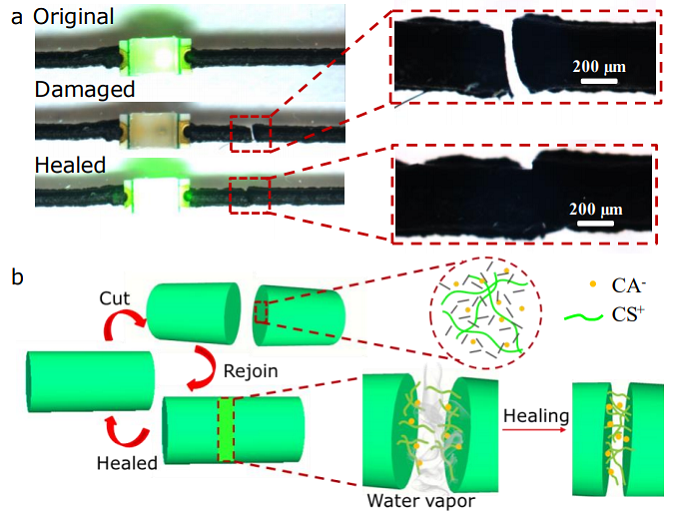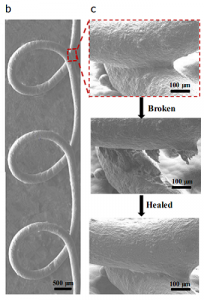 A group of researchers from Canada’s Research Center for High Performance Polymer and Composite Systems (CREPEC) at the Polytechnique Montréal recently submitted a paper, titled “3D Printing of Self-Healing and Stretchable Nanocomposites Sensors,” in Materials Horizons that explains how they developed a self-healing nanocomposite, made of chitosan (CS) and carbon nanotubes (CNT), that can heal damage once it’s exposed to water vapor at room temperature.
A group of researchers from Canada’s Research Center for High Performance Polymer and Composite Systems (CREPEC) at the Polytechnique Montréal recently submitted a paper, titled “3D Printing of Self-Healing and Stretchable Nanocomposites Sensors,” in Materials Horizons that explains how they developed a self-healing nanocomposite, made of chitosan (CS) and carbon nanotubes (CNT), that can heal damage once it’s exposed to water vapor at room temperature.
The abstract reads, “In this work, we report a novel multifunctional material with self-healing ability and electrical conductivity based on chitosan (CS) and multiwall carbon nanotubes (CNT) (30 wt%). The self-healing of the nanocomposites can be achieved with the assistance of water vapor. The self-healing process is rapid, occurring within seconds to heal the damage. Upon drying, the conductivity can be restored. The nanocomposite is processed by instability-assisted 3D printing at room temperature for producing highly tunable microstructured fibers. The microstructured fibers featuring sacrificial bonds and hidden lengths endow the nanocomposite with high stretchability (strain at break of 180%). Exposure the CS/CNT microstructured fibers to water vapor can restore their mechanical properties (e.g., flexibility, strength and toughness) after healing their broken sacrificial bonds. Granted with properties such as self-healing, stretchability and conductivity, CS/CNT nanocomposite strain sensor are developed to detect human elbow motion and local deformation.”
There are many applications for stretchable, self-healing devices made from sustainable materials, such as biomedical devices, soft robotics, and wearable sensors, because of their restorative properties and low cost. But, due to an increasing demand for more powerful electronics, electronic waste that contains non-biodegradable and toxic materials is a big problem. While there has been research conducted on designing self-healing materials based on autonomic healing, among other features, they can’t really be used in electronics due to a lack of electrical conductivity.

(a) CS/CNT ink preparation. (b) Electrical conductivity of CS/CNT nanocomposites with different CNT contents. The zone at the left of the vertical dashed line represents 3D printable inks with CNT content lower than 30 wt %. (c) 20-layer scaffold, spider, and starfish shaped structures fabricated by 3D printing, which undergo solvent evaporation to solidify the structures. (d) Schematic of instability-assisted 3D printing (IA3DP).
“It remains a challenge to combine eco-friendly material, easy processing, fast and repeatable healing properties, high stretchability and complex structures into material design for electronic applications,” the researchers wrote.
The team turned to 3D printing, which is a low-cost way to accurately fabricate electronic devices. While it’s necessary to have a high loading (20 wt %) of CNTs to make a conductive nanocomposite, this level of concentration in the polymer binder lowers the stretchability. Instability-assisted 3D printing (IA3DP) of PLA fibers, however, can improve this property for polymers.
(b) SEM images of coiling pattern CS/CNT fiber (30 wt % CNT) with three bonds. (c) Top: high magnification of original sacrificial bond in c, middle: bond in broken and healed (bottom) states.
“Here, we report a self-healing chitosan (CS)/carbon nanotubes (CNT) nanocomposite that is able to heal damage under exposure to water vapor at room temperature. The nanocomposite can be fabricated with microstructured fibers featuring sacrificial bond and hidden length by instability-assisted 3D printing (IA3DP). The resultant as-printed CS/CNT structure retains its hierarchical architecture and exhibits excellent mechanical properties,” the researchers wrote. “A conductivity as high as ~ 1450 S/m was measured, which is higher than previously reported chitosan-based CNT nanocomposites (e.g., ~ 500 S/m).35-37 The microstructure of completely or partially broken CS/CNT fibers (e.g., cut straight fibers or broken sacrificial bonds in microstructured fibers) can be restored, as well as their electrical and mechanical properties after exposing to water vapor. This water-vapor triggered nanocomposite allows processing multidimensional architectures and develop functional sensors that are capable of sensing humidity and strain.”
The team developed a novel CS/CNT ink, made up of a blend of CNTs, CS as polymer binder, and a dispersing solution of distilled water and acetic, citric, and lactic acids. Then, the ink was used to make complex 3D structures and microstructured fibers with a combination of IA3DP and solvent-cast 3D printing (SC3DP).
The researchers performed electrical conductivity tests on fibers of the CS/CNT nanocomposites, in addition to mechanical tests on both straight and coil-patterned fibers.

(a) SEM images of CS/CNT nanocomposite (30 wt % CNT) morphology in the cross-section of a CS/CNT fiber. (b), (c) and (d) show CNT homogeneous distribution in the nanocomposite at higher magnification images of its morphology at different positions (i, ii, and iii) in (a).
In order to test the seal-healing behavior, the team cut the CS/CNT fibers with a standard razor blade, and then sprayed water vapor on the samples for 10 seconds. A humidifier was then used to heal the cut fibers, and then they were dried by a hair dryer until “the current back to the initial values.”
The researchers then performed electrical measurements on both the original and healed fibers.
The team’s work is already shedding more light on using high stretchability and self-healing ability in sensor design. In addition, the paper is showcasing the use of biodegradable polymers that “leads to a class of electronic materials for excellent performance and functionality of electronic devices.”
“By applying structural hierarchy, microstructured fiber with sacrificial bond and hidden length endow a high stretchability (maximum strain of 180 %) of the CS/CNT nanocomposite with a high CNT content (30 wt %). This room-temperature processed, fast and repeatable self-healing electronic nanocomposite material can restore its outstanding mechanical properties (i.e., stretchability, strength and toughness) and high electrical conductivity by simply applying water vapor,” the researchers concluded. “These CS/CNT nanocomposite instability-assisted 3D printed structures can be designed as multifunctional devices including humidity and strain sensors. The humidity sensor presents a reversible sensing ability and strain sensors are capable of sensing human motion and local deformation. The restoration of nanocomposite shape and electrical properties can be achieved either through structure design (e.g., using flexible supportive substrate) or the healing properties of nanocomposites. This work not only develops a simple strategy to design CS/CNT nanocomposites with self-healing properties, but also demonstrates the 3D printing of multidimensional structures as well as the development of strain sensor applications.”

(a) Optical microscopy images of a CS/CNT fiber at original, damaged and healed states to turn on or off a LED light bulb, and images at a higher magnification showing the damaged and healed regions on the fiber. (b) Schematic illustration of the healing process of a CS/CNT fiber exposed to water vapor, which increases the swelling of the CS polymer and thus favors the chain movement and electrostatic interactions between CA- and CS+.
Co-authors are Qinghua Wu, Shibo Zou, Frédérick Gosselin, Daniel Therriault, and Marie-Claude Heuzey.
Discuss this and other 3D printing topics at 3DPrintBoard.com or share your thoughts below.
Subscribe to Our Email Newsletter
Stay up-to-date on all the latest news from the 3D printing industry and receive information and offers from third party vendors.
You May Also Like
Gorilla Sports GE’s First 3D Printed Titanium Cast
How do you help a gorilla with a broken arm? Sounds like the start of a bad joke a zookeeper might tell, but it’s an actual dilemma recently faced by...
Nylon 3D Printed Parts Made More Functional with Coatings & Colors
Parts 3D printed from polyamide (PA, Nylon) 12 using powder bed fusion (PBF) are a mainstay in the additive manufacturing (AM) industry. While post-finishing processes have improved the porosity of...
$25M to Back Sintavia’s Largest Expansion of Metal 3D Printing Capacity Since 2019
Sintavia, the digital manufacturing company specializing in mission-critical parts for strategic sectors, announced a $25 million investment to increase its production capacity, the largest expansion to its operations since 2019....
Velo3D Initiates Public Offering in a Bid to Strengthen Financial Foundations and Drive Future Growth
Velo3D (NYSE: VLD) has been among a number of publicly traded 3D printing firms that have attempted to weather the current macroeconomic climate. After posting a challenging financial report for 2023,...
































